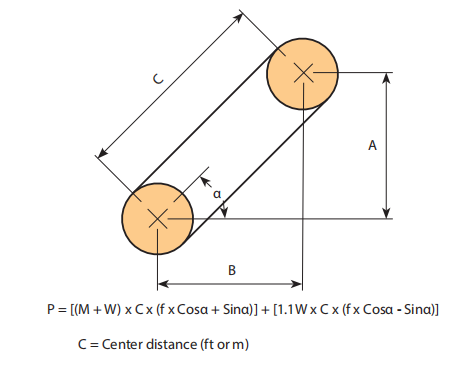Introduction
A careful evaluation from the disorders surrounding a conveyor is important for precise conveyor chain choice. This area discusses the fundamental considerations essential for prosperous conveyor chain choice. Roller Chains tend to be utilized for light to moderate duty materials managing applications. Environmental conditions may well require the usage of special components, platings coatings, lubricants or even the capacity to operate without having extra external lubrication.
Standard Data Required For Chain Variety
? Type of chain conveyor (unit or bulk) together with the method of conveyance (attachments, buckets, as a result of rods etc).
? Conveyor layout like sprocket areas, inclines (if any) as well as amount of chain strands (N) to be utilised.
? Amount of material (M in lbs/ft or kN/m) and style of material for being conveyed.
? Estimated fat of conveyor components (W in lbs/ft or kN/m) which includes chain, slats or attachments (if any).
? Linear chain speed (S in ft/min or m/min).
? Environment through which the chain will operate which include temperature, corrosion circumstance, lubrication affliction and so forth.
Phase 1: Estimate Chain Tension
Make use of the formula below to estimate the conveyor Pull (Pest) after which the chain tension (Check). Pest = (M + W) x f x SF and
Check = Pest / N
f = Coefficient of Friction
SF = Velocity Element
Step two: Make a Tentative Chain Assortment
Working with the Check worth, produce a tentative variety by picking out a chain
whose rated working load better compared to the calculated Check value.These values are acceptable for conveyor service and are diff erent from individuals shown in tables on the front in the catalog that are related to slow velocity drive chain utilization.
Moreover to suffi cient load carrying capability normally these chains has to be of the particular pitch to accommodate a preferred attachment spacing. For instance if slats are for being bolted to an attachment each and every one.5 inches, the pitch from the chain chosen have to divide into one.5?¡À. Thus 1 could use a forty chain (1/2?¡À pitch) with the attachments each and every 3rd, a 60 chain (3/4?¡À pitch) using the attachments each 2nd, a 120 chain (1-1/2?¡À pitch) together with the attachments every pitch or a C2060H chain (1-1/2?¡À pitch) together with the attachments every pitch.
Phase three:  Finalize Assortment – Calculate Real Conveyor Pull
Finalize Assortment – Calculate Real Conveyor Pull
Soon after building a tentative selection we need to confirm it by calculating
the actual chain stress (T). To perform this we should fi rst determine the real conveyor pull (P). In the layouts proven over the correct side of this web page opt for the appropriate formula and determine the complete conveyor pull. Note that some conveyors may be a mixture of horizontal, inclined and vertical . . . in that situation calculate the conveyor Pull at every single section and include them collectively.
Step four: Calculate Greatest Chain Tension
The maximum Chain Stress (T) equals the Conveyor Pull (P) as calculated in Step three divided from the quantity of strands carrying the load (N), occasions the Velocity Factor (SF) proven in Table 2, the Multi-Strand Element (MSF) proven in Table three as well as the Temperature Element (TF) shown in Table 4.
T = (P / N) x MSF x SF x TF
Stage five: Examine the ?¡ãRated Working Load?¡À from the Chosen Chain
The ?¡ãRated Operating Load?¡À in the picked chain should really be greater compared to the Greatest Chain Stress (T) calculated in Step 4 above. These values are suitable for conveyor support and therefore are diff erent from people proven in tables at the front from the catalog that are related to slow speed drive chain utilization.
Stage 6: Verify the ?¡ãAllowable Roller Load?¡À of your Picked Chain
For chains that roll within the chain rollers or on prime roller attachments it can be essential to check out the Allowable Roller Load?¡À.
Note: the Roller load is determined by:
Roller Load = Wr / Nr
Wr = The complete weight carried from the rollers
Nr = The number of rollers supporting the excess weight.